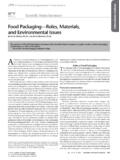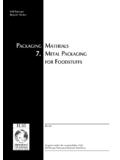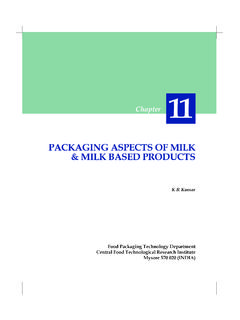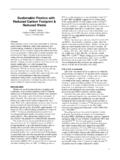Transcription of Packaging Machinery Handbook
1 Packaging Machinery Handbook The complete guide to automated Packaging Machinery , including Packaging line design John R. Henry Certified Packaging Professional (CPP) This sample contains selections from 2 chapters of the Packaging Machinery Handbook . It may be freely copied and shared provided that it remains intact with no alterations or deletions. The complete book may be ordered by scanning the QR or at: Log in to Create Space using your Amazon account Use discount code HZ42CJ99 at checkout to receive 20% off. Schools contact the author for special educational discount. To contact the author TABLE OF CONTENTS CHAPTER TITLE PAGE 1 Introduction 13 2 Line loading 30 3 Flexible Packaging 46 4 Filling 76 5 Capping and closing 115 6 Labeling 148 7 Coding and inline printing 189 8 Inspecting 213 9 Cartoning and case packing 238 10 Conveying.
2 Buffering and accumulating 266 11 Packaging machine components and controls 300 12 Packaging line design 327 About the author 362 Order the Packaging Machinery Handbook at 3 CHAPTER 6 LABELING Labeling is defined as affixing printed or graphic material onto the package or product. It does not include direct printing or decorating on the package that will be covered in Chapter 7 Coding and Inline Printing. The primary purpose of most labels is to inform, that is identify, warn, sell or some other reason. But labels serve other purposes as well. They can provide tamper evidency, group multiple products and close packages. Labels may also take the form of multi-page coupon or instruction books. Labeling technology may also be used to apply non-label components, such as hang tags and anti-shoplifting tags.
3 This chapter will examine the different types of labels in common use and technologies used to apply them to containers and packages. LABEL TYPES In discussing labels, front will refer to the outside, non-glued face. Back will refer to the container or glue side of the label. Label length will be the dimension of the label in the direction of application. In the case of roll-fed labels, it will be the length along the roll. Label width will be the dimension of the label perpendicular to the direction of application. Labels fall into two major categories: flat and sleeve. Flat labels are individual pieces of film, foil, plastic, paper or composite materials affixed to the product with an adhesive. Sleeve labels are films formed into a continuous tube and supplied on rolls.
4 Sleeves are cut to length and applied over the package. They are normally held in place by friction and container design but adhesive is sometimes used to help hold it in position. The most common class of sleeve labels use a heat shrinkable film. Once applied, they are shrunk to conform tightly to the package shape. Log in using your Amazon account and use discount code HZ42CJ99 for 20% off. 4 Flat labels can be supplied as a continuous web (roll-fed) or as individual cut labels (typically referred to as cut-and-stack labels). Flat labels can have square ends (butt cut) or can be die cut into almost any shape. Roll-fed labels can be oriented in any of eight positions, called unwind position, and numbered 1 through 8. Although there are eight positions, 5 through 8 are seldom used in Packaging .
5 Some unwind charts will show only four positions. This is an industry standard and specifying an unwind position number should be sufficient. Since should be is not always the same as is, one precaution when dealing with label converters, as well as with labeling machine builders, is to always send an unwind chart with the desired position circled. Label unwind positions By the author, used courtesy of the Institute of Packaging Professionals Flat labels are available with a variety of adhesives. The adhesive used will depend on the label material, the substrate or package it's applied to and the label's intended purpose. A label for a frozen food carton will require a different adhesive than a label for a glass bottle at room temperature. This book will not discuss adhesives in depth other than as they relate to the labeling system.
6 Technically glue and adhesive have different meanings though similar functions. In modern usage the terms are generally interchangeable and this chapter will use both words to mean the same thing. One method of classifying label applicating systems, other than sleeve labels, is by the type of adhesive they use. The four major classifications are: pressure sensitive; heat Order the Packaging Machinery Handbook at 5 activated; cold/wet adhesive; and hot-melt adhesive. PRESSURE-SENSITIVE LABELING Pressure-sensitive (P-S) labels are labels with pre-applied adhesive that requires no activation (unlike heat-activated labels which come with pre-applied adhesive which requires heat to activate). The labels are supplied in roll form on a backing web, called a liner. The coated paper or plastic film liner allows the label adhesive to bind with a relatively high shear but relatively low tack strength.
7 This prevents the label from sliding out of position on the web yet allows it to be easily removed at time of application. The web material is important since it is pulled through the labeler, dispensing the label as it goes. If it does not have sufficiently high tensile strength to withstand the continuous jerking as the label is dispensed, frequent breakages will occur resulting in lost production. Paper-based webs are also susceptible to nicking. A small nick in the edge of the web will generally cause the web to break. Paper web material is usually satisfactory for most applications, especially at lower speeds with smaller label sizes Plastic backing webs are stronger and much less susceptible to tearing and should be used for higher speeds, narrow labels, complex die cuts or other applications where web breakage might occur.
8 Labels are generally supplied on rolls although a few applications will use fan-folded labels. Fan-folded labels are folded into layers and supplied in boxes rather than on rolls. Fan folding allows continuous labels to be printed on some types of computer printers. They also allow for non-stop operation as the tail end of the current box of labels can be pulled out and spliced to the leading edge of the next box. The industry standard for roll labels is normally specifies that the roll will be 12-inch outside diameter with a 3-inch core. For higher speed operations, or where the label is particularly long or thick, larger diameter rolls can maximize the time between roll changes. Sixteen- and 24-inch rolls may be used but bring their own issues: They will be heavier and more difficult to handle.
9 Narrower labels will also be more susceptible to telescoping as the roll diameter increases. Care in handling, combined with specialized handling systems, can minimize these problems. Occasionally other core sizes may be used. Log in using your Amazon account and use discount code HZ42CJ99 for 20% off. 6 Most pressure-sensitive labels are die cut. They are printed on a continuous film, adhered to the backing web and a die-cutting machine cuts the label shape. The waste material is then removed, leaving the label isolated on the web. The industry standard for the gap between labels is 1/8-inch with the backing web extending 1/16-inch to either side. In some cases wider or narrower gaps may be specified. Labels are normally in a single row on the web. In some cases, multiple labels may be cut on a single web.
10 An example is a label that must be applied to two thermoformed packages made in a single cycle of the thermoforming machine. By placing two labels side by side on the web, appropriately spaced for the packages, the need for two labelers is avoided. Occasionally, pressure-sensitive labels will be butt-cut. Instead of using the die to cut away waste material, the die simply cuts in between each label. The label extends all the way to the edge of the web. Most pressure-sensitive labeling applications require a gap between labels for sensing. If butt cut labels are used, a registration mark will be required. The term labeling head refers to the system that dispenses the label. The labeling head is combined with an applicator system and a container handling system to form a complete labeling system.







